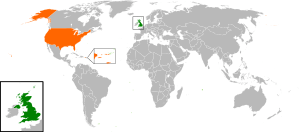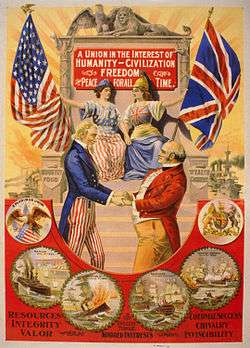British Americans
British American usually refers to Americans whose ancestral origin originates wholly or partly in the United Kingdom (England, Scotland, Wales and Northern Ireland). In the 2017 American Community Survey 1,891,234 individuals or 0.6% of the responses self-identified as British.[1] It is primarily a demographic or historical research category for people who have at least partial descent from peoples of Great Britain and the modern United Kingdom, i.e. English, Scottish, Welsh, Scotch-Irish, Manx and Cornish Americans. There has been a significant drop overall, especially from the 1980 census where 49.59 million people reported English ancestry.
  | |
| Total population | |
|---|---|
| Self-identified as British 1,891,234 0.6% of the total U.S. population. Other estimates: 90,573,000[2] 23.3% of the total U.S. population | |
| Regions with significant populations | |
| Throughout the entire United States except parts of the Midwest Predominantly in the South, Northeast and West regions. | |
| Languages | |
| English (American English, British English), Goidelic languages, Scots, Welsh | |
| Religion | |
| Christian Mainly Protestant (especially Baptist, Congregationalist, Episcopalian, Methodist, Presbyterian and Quaker) and to a lesser extent Catholic and Mormon | |
| Related ethnic groups | |
Demographers regard current figures as a serious under-count, as a large proportion of Americans of British descent have a tendency to identify as 'American' since 1980 where over 13.3 million or 5.9% of the total U.S. population self-identified as "American" or "United States", this was counted under "not specified".[3] This response is highly overrepresented in the Upland South, a region settled historically by the British.[4][5][6][7][8][9] Many of mixed European ancestry, may identify with a more recent and differentiated ethnic group.[10] Of the top ten family names in the United States (2010), seven have English origins or having possible mixed British Isles heritage, the other three being of Spanish origin.[11]
Not to be confused when the term is also used in an entirely different (although possibly overlapping) sense to refer to people who are dual citizens of both the United Kingdom and the United States.
Sense of heritage
Americans of British heritage are often seen, and identify, as simply "American" due to the many historic, linguistic and cultural ties between Great Britain and the U.S. and their influence on the country's population. A leading specialist, Charlotte Erickson, found them to be ethnically "invisible".[12] This may be due to the early establishment of British settlements; as well as to non-English groups having emigrated in order to establish significant communities.[13]
Number of British Americans
Table below shows the results from 1980 when ancestry was first collected by the U.S. census and the 2010 American Community Survey. Response rates for the ancestry question was 90.4% in 1990 and 80.1% in 2000 for the total US population.
.png)
| Year | Ancestral origin | Number | % of population |
|---|---|---|---|
| British; totals | 61,327,867 | 31.67% | |
| 1980 | English | 49,598,035 | 26.34% |
| Scottish | 10,048,816 | 4.44% | |
| Welsh | 1,664,598 | 0.88% | |
| Northern Irelander | 16,418 | 0.01% | |
| Total | 46,816,175 | 18.8% | |
| 1990 | English | 32,651,788 | 13.1% |
| Scottish | 5,393,581 | 2.2% | |
| Scotch-Irish | 5,617,773 | 2.3% | |
| Welsh | 2,033,893 | 0.8% | |
| British | 1,119,140 | 0.4% | |
| Total | 36,564,465 | 12.9% | |
| 2000 | English | 24,515,138 | 8.7% |
| Scottish | 4,890,581 | 1.7% | |
| Scotch-Irish | 4,319,232 | 1.5% | |
| Welsh | 1,753,794 | 0.6% | |
| British | 1,085,720 | 0.4% | |
| Total | 37,619,881 | 14.4% | |
| 2010 | English | 25,927,345 | 8.4% |
| Scottish | 5,460,679 | 3.1% | |
| Scotch-Irish | 3,257,161 | 1.9% | |
| Welsh | 1,793,356 | 0.6% | |
| British | 1,181,340 | 0.4% | |
| Source:United States Census Bureau.[14][15][16][17][18] | |||
Composition of Colonial America
According to estimates by Thomas L. Purvis (1984), published in the European ancestry of the United States, gives the ethnic composition of the American colonies from 1700 to 1755. British ancestry in 1755 were estimated to be 52% English and Welsh, 7.0% Scots-Irish and 4% Scottish.[20]
Studies on origins, 1790
The ancestry of the 3,929,214 population in 1790 has been estimated by various sources by sampling last names in the very first United States official census and assigning them a country of origin.[21] There is debate over the accuracy between the studies with individual scholars and the Federal Government using different techniques and conclusion for the ethnic composition.[22][21] A study published in 1909 titled A Century of Population Growth by the Census Bureau estimated the British origin combined were around 90% of the white population.[23][24][25]
Another source by Thomas L. Purvis in 1984[26] estimated that people of British ancestry made up about 62% of the total population or 74% of the white or European American population.[27] Some 81% of the total United States population was of European heritage.[28] Around 757,208 were of African descent with 697,624 being slaves.[29]
1980
The 1980 census was the first that asked people's ancestry.[30] The 1980 United States Census reported 61,327,867 individuals or 31.67% of the total U.S. population self-identitfied as having British descent. In 1980 16,418 Americans reported ‘Northern Islander’. No Scots-Irish (descendants of Ulster-Scots) ancestry was recorded, however over ten million people identified as Scottish.[31] This figure fell to over 5 million each in the following census when the Scotch-Irish were first counted.[32]
1990
Over 90.4% of the United States population reported at least one ancestry, 9.6% (23,921,371) individuals as "not stated" with a total of 11.0% being "not specified".[33] Additional responses were Cornish (3,991), Northern Irish 4,009 and Manx 6,317.[34]
2000
Most of the population who stated their ancestry as "American" (20,625,093 or 7.3%) are said to be of old colonial British ancestry.[35]
| 2000 Census[36] | ||
|---|---|---|
| Ancestry | Number | % of total |
| German | 42,885,162 | 15.2 |
| African | 36,419,434 | 12.9 |
| Irish | 30,594,130 | 10.9 |
| English | 24,515,138 | 8.7 |
| Mexican | 20,640,711 | 7.3 |
| Italian | 15,723,555 | 5.6 |
| French | 10,846,018 | 3.9 |
| Hispanic | 10,017,244 | 3.6 |
| Polish | 8,977,444 | 3.2 |
| Scottish | 4,890,581 | 1.7 |
| Dutch | 4,542,494 | 1.6 |
| Norwegian | 4,477,725 | 1.6 |
| Scotch-Irish | 4,319,232 | 1.5 |
| United States | 281,421,906 | 100 |
Geographical distribution
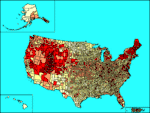

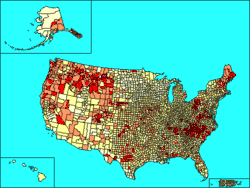
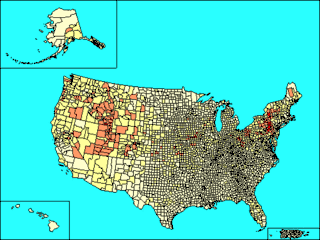
Following are the top 10 highest percentage of people of English, Scottish and Welsh ancestry, in U.S. communities with 500 or more total inhabitants (for the total list of the 101 communities, see references)[37][38][39]
English
- Hildale, UT 66.9%
- Colorado City, AZ 52.7%
- Milbridge, ME 41.1%
- Panguitch, UT 40.0%
- Beaver, UT 39.8%
- Enterprise, UT 39.4%
- East Machias, ME 39.1%
- Marriott-Slaterville, UT 38.2%
- Wellsville, UT 37.9%
- Morgan, UT 37.2%
Scottish
- Lonaconing, MD town 16.1%
- Jordan, IL township 12.6%
- Scioto, OH township 12.1%
- Randolph, IN township 10.2%
- Franconia, NH town 10.1%
- Topsham, VT town 10.0%
- Ryegate, VT town 9.9%
- Plainfield, VT town 9.8%
- Saratoga Springs, UT town 9.7%
- Barnet, VT town 9.5%
Welsh
- Malad City, ID city 21.1
- Remsen, NY town 14.6
- Oak Hill, OH village 13.6
- Madison, OH township 12.7
- Steuben, NY town 10.9
- Franklin, OH township 10.5
- Plymouth, PA borough 10.3
- Jackson, OH city 10.0
- Lake, PA township 9.9
- Radnor, OH township 9.8
History
Overview
The British diaspora consists of the scattering of British people and their descendants who emigrated from the United Kingdom. The diaspora is concentrated in countries that had mass migration such as the United States and that are part of the English-speaking world. A 2006 publication from the Institute for Public Policy Research estimated 5.6 million British-born people lived outside of the United Kingdom.[40][41]
After the Age of Discovery the British were one of the earliest and largest communities to emigrate out of Europe, and the British Empire's expansion during the first half of the 19th century saw an "extraordinary dispersion of the British people", with particular concentrations "in Australasia and North America".[42]
The British Empire was "built on waves of migration overseas by British people",[43] who left the United Kingdom and "reached across the globe and permanently affected population structures in three continents".[42] As a result of the British colonization of the Americas, what became the United States was "easily the greatest single destination of emigrant British".[42]
Historically in the 1790 United States Census estimate and presently in Australia, Canada and New Zealand "people of British origin came to constitute the majority of the population" contributing to these states becoming integral to the Anglosphere.[43] There is also a significant population of people with British ancestry in South Africa.
Colonial period
An English presence in North America began with the Roanoke Colony and Colony of Virginia in the late-16th century, but the first successful English settlement was established in 1607, on the James River at Jamestown. By the 1610s an estimated 1,300 English people had travelled to North America, the "first of many millions from the British Isles".[44] In 1620 the Pilgrims established the English imperial venture of Plymouth Colony, beginning "a remarkable acceleration of permanent emigration from England" with over 60% of trans-Atlantic English migrants settling in the New England Colonies.[44] During the 17th century an estimated 350,000 English and Welsh migrants arrived in North America, which in the century after the Acts of Union 1707 was surpassed in rate and number by Scottish and Irish migrants.[45]
%2C_by_John_Trumbull.jpg)
The British policy of salutary neglect for its North American colonies intended to minimize trade restrictions as a way of ensuring they stayed loyal to British interests.[46] This permitted the development of the American Dream, a cultural spirit distinct from that of its European founders.[46] The Thirteen Colonies of British America began an armed rebellion against British rule in 1775 when they rejected the right of the Parliament of Great Britain to govern them without representation; they proclaimed their independence in 1776, and subsequently constituted the first thirteen states of the United States of America, which became a sovereign state in 1781 with the ratification of the Articles of Confederation. The 1783 Treaty of Paris represented Great Britain's formal acknowledgement of the United States' sovereignty at the end of the American Revolutionary War.[47]
In the original 13 colonies, most laws contained elements found in the English common law system.[48]
The vast majority of the Founding Fathers of the United States were of mixed British extraction. Most of these were of English descent, with smaller numbers of those of Scottish, Irish or Scots-Irish, and Welsh ancestry. A minority were of high social status and can be classified as White Anglo-Saxon Protestant (WASP). Many of the prewar WASP elite were Loyalists who left the new nation.[49]
Immigration after 1776
| British immigration to the U.S. 1820-2000 | |||||
|---|---|---|---|---|---|
| Period | Arrivals | Period | Arrivals | Period | Arrivals |
| 1820-1830 | 27,489 | 1901-1910 | 525,950 | 1981-1990 | 159,173 |
| 1831-1840 | 75,810 | 1911-1920 | 341,408 | 1991-2000 | 151,866 |
| 1841-1850 | 267,044 | 1921-1930 | 339,570 | ||
| 1851-1860 | 423,974 | 1931-1940 | 31,572 | ||
| 1861-1870 | 606,896 | 1941-1950 | 139,306 | ||
| 1871-1880 | 548,043 | 1951-1960 | 202,824 | ||
| 1881-1890 | 807,357 | 1961-1970 | 213,822 | ||
| 1891-1900 | 271,538 | 1971-1980 | 137,374 | ||
| Total arrivals: 5,271,016[50][51][52][53] | |||||
Nevertheless, longstanding cultural and historical ties have, in more modern times, resulted in the Special Relationship, the exceptionally close political, diplomatic and military co-operation of United Kingdom – United States relations.[54] Linda Colley, a professor of history at Princeton University and specialist in Britishness, suggested that because of their colonial influence on the United States, the British find Americans a "mysterious and paradoxical people, physically distant but culturally close, engagingly similar yet irritatingly different".[55]
For over two centuries (1789-1989) of early U.S. history, all Presidents with the exception of two (Van Buren and Kennedy) were descended from the varied colonial British stock, from the Pilgrims and Puritans to the Scotch-Irish and English who settled the Appalachia.[56]
Cultural contributions
Much of U.S. culture shows influences from nation states of British culture. Colonial ties to Great Britain spread the English language, legal system and other cultural attributes.[57] Historian David Hackett Fischer has posited that four major streams of immigration from the British Isles in the colonial era contributed to the formation of a new American culture, summarised as follows:
- East Anglia to New England - The Exodus of the English Puritans (Pilgrims and Puritans influenced the Northeastern United States' corporate and educational culture)[58]
- The South of England to the lowland South - The Cavaliers and Indentured Servants (Gentry influenced the Southern United States' plantation culture)[59]
- Northern England to the Delaware Valley - The Friends' Migration (Quakers influenced the Middle Atlantic and Midwestern United States' industrial culture)[60]
- The Scottish Lowlands to the Backcountry - The Flight from North Britain (Scotch-Irish, of lowland Scottish and border English descent, influenced the Western United States' ranch culture and the Southern United States' common agrarian culture)[61]
Fischer's theory acknowledges the presence of other groups of immigrants during the colonial period, both from the British Isles (the Welsh and the Highland Scots) and not (Germans, Dutch, and French Huguenots), but believes that these did not culturally contribute as substantially to the United States as his main four.
Historical influence
Apple pie – New England was the first region to experience large-scale English colonization in the early 17th century, beginning in 1620, and it was dominated by East Anglian Calvinists, better known as the Puritans. Baking was a particular favorite of the New Englanders and was the origin of dishes seen today as quintessentially "American", such as apple pie and the oven-roasted Thanksgiving turkey.[62] "As American as apple pie" is a well-known phrase used to suggest that something is all-American.
Automakers
Buick – David Dunbar Buick was a Scottish-born American, a Detroit-based inventor, best known for founding the Buick Motor Company.
Motorcycle manufacturer
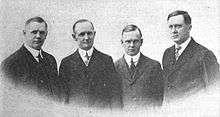
Harley-Davidson – The Davidson brothers were of Scottish descent (William. A., Walter and Arthur Davidson) and William S. Harley of English descent. Along with Indian Motorcycle Manufacturing Company was the largest and most recognizable American motorcycle manufacturer.[63]
Sports
Baseball - The earliest recorded game of base-ball for which the original source survives, involved the family of George II of Great Britain, played indoors in London in November 1748. The Prince is reported as playing "Bass-Ball" again in September 1749 in Walton-on-Thames, Surrey, against Lord Middlesex.[64] The English lawyer William Bray wrote in his diary that he had played a game of baseball on Easter Monday 1755 in Guildford, also in Surrey.[65][66] English lawyer William Bray recorded a game of baseball on Easter Monday 1755 in Guildford, Surrey; Bray's diary was verified as authentic in September 2008.[67][68] This early form of the game was apparently brought to North America by British immigrants. The first appearance of the term that exists in print was in "A Little Pretty Pocket-Book" in 1744, where it is called Base-Ball. Today, Rounders which has been played in England since Tudor times holds a similarity to Baseball. Although, literary references to early forms of "base-ball" in the United Kingdom pre-date use of the term "rounders".[69]
Continental Colours, 1775-1777
.svg.png)
The Grand Union Flag is considered to be the first national flag of the United States.[70] The design consisted of 13 stripes, red and white, representing the original Thirteen Colonies, the canton on the upper left-hand corner bearing the British Union Flag, the red cross of St. George of England with the white cross of St. Andrew of Scotland. The flag was first flown on December 2, 1775 by John Paul Jones (then a Continental Navy lieutenant) on the ship Alfred in Philadelphia).[71]
Place names
Alabama
- Birmingham after Birmingham, England
Connecticut
- Essex, Connecticut after Essex, England
- Greenwich, Connecticut after Greenwich, England
- Manchester, Connecticut after Manchester, England
- New London, Connecticut after London, England
- Norfolk, Connecticut after Norfolk, England
Delaware
- Dover after Dover, England
- Kent County, Delaware after Kent, England
- Wilmington named by Proprietor Thomas Penn after his friend Spencer Compton, Earl of Wilmington, who was prime minister in the reign of George II of Great Britain.
Maryland
- Aberdeen, Maryland after Aberdeen, Scotland
- Chester, Maryland after Chester, England
- Chestertown, Maryland after Chester, England
- Essex, Maryland after Essex, England
- Glencoe, Maryland after Glencoe, Scotland
- Hereford, Maryland after Hereford, England
- Kensington, Maryland after Kensington, England
- Manchester, Maryland after Manchester, England
- Olney, Maryland after Olney, England
- Westminster, Maryland after Westminster, England
- Salisbury, Maryland after Salisbury, England
Massachusetts
- Bedford, Massachusetts after Bedford, England
- Boston after Boston, England[72]
- Cambridge after the City of Cambridge, England[73]
- Falmouth, Massachusetts after Falmouth, England
- Gloucester after Gloucester, England
- Hampshire County, Massachusetts after Hampshire, England
- Middlesex County, Massachusetts after Middlesex, England
- Plymouth, Massachusetts after Plymouth, England
- Southampton after Southampton, England[74]
- Suffolk County, Massachusetts after Suffolk, England
- Swansea, Massachusetts after Swansea, Wales
- Weymouth, Massachusetts after Weymouth, Dorset, England
- Worcester, Massachusetts after Worcester, England
New Hampshire
- New Hampshire state (after Hampshire[75])
- Derry, New Hampshire after Derry, Northern Ireland
- Durham, New Hampshire after Durham, England
- Exeter, New Hampshire after Exeter, England
- Londonderry, New Hampshire after Londonderry, Northern Ireland
- Manchester after Manchester, England[76]
- New London, New Hampshire after London, England
- Plymouth, New Hampshire after Plymouth, England
- Portsmouth, New Hampshire after Portsmouth, England
New York State
- New York (state) and New York City after York, England
Pennsylvania
- Bucks County after Buckinghamshire, England
- Chester County and Chester after Chester, England
- Carlisle, Pennsylvania after Carlisle, England
- Darby derived from Derby (pronounced "Darby"), the county town of Derbyshire (pronounced "Darbyshire")[77]
- Lancaster County and Lancaster after the city of Lancaster in the county of Lancashire in England, the native home of John Wright, one of the early settlers.[78]
- Reading, Berks County after Reading, Berkshire, England
- Warminster after a small town in the county of Wiltshire, at the western extremity of Salisbury Plain, England.[79]
- York, Pennsylvania after York, England
Virginia
- Crewe, Virginia after Crewe, England
- Dumfries, Virginia after Dumfries, Scotland
- Edinburg, Virginia after Edinburgh, Scotland
- Falmouth, Virginia after Falmouth, England
- Isle of Wight County, Virginia after Isle of Wight, England
- Kilmarnock, Virginia after Kilmarnock, Scotland
- Glasgow, Virginia after Glasgow, Scotland
- Gloucester, Virginia after Gloucester, England
- Richmond, Virginia and Richmond County, Virginia after Richmond, London
- Lancaster County, Virginia after Lancashire, England
- Hampton, Virginia after Hampton, London, England
- Midlothian, Virginia after Midlothian, Scotland
- New Kent County, Virginia after Kent County, England
- Norfolk, Virginia after Norfolk, England
- Northampton County, Virginia after Northampton, England
- Northumberland County, Virginia after Northumberland, England
- Portsmouth, Virginia after Portsmouth, England
- Stafford, Virginia after Stafford, England
- Suffolk, Virginia after Suffolk, England
- Westmoreland County, Virginia after Westmoreland (now part of Cumbria, England)
- Winchester, Virginia after Winchester, England
In addition, some places were named after the kings and queens of the former kingdoms of England and Ireland. The name Virginia was first applied by Queen Elizabeth I (the "Virgin Queen") and Sir Walter Raleigh in 1584.,[80] the Carolinas were named after King Charles I and Maryland named so for his wife, Queen Henrietta Maria (Queen Mary). The Queens in New York was named after Catherine of Braganza (Queen Catherine), the wife of the King Charles II.[81]
See also
- Anglo-Celtic Australians
- Hyphenated American
- English diaspora
- List of English Americans
- List of Scots-Irish Americans
- List of Scottish Americans
- List of Welsh Americans
- Americans in the United Kingdom
References
- SELECTED POPULATION PROFILE IN THE UNITED STATES - 2017 American Community Survey 1-Year Estimates
- "About Ancestry.co.uk". Ancestry.co.uk. Retrieved 17 March 2015.
- Ancestry of the Population by State: 1980 (Supplementary Report PC80-S1-10) Issued: April 1983
- Ethnic Landscapes of America - By John A. Cross
- Census and you: monthly news from the U.S. Bureau... Volume 28, Issue 2 - By United States. Bureau of the Census
- Dominic J. Pulera. Sharing the Dream: White Males in a Multicultural America.
- Reynolds Farley, 'The New Census Question about Ancestry: What Did It Tell Us?', Demography, Vol. 28, No. 3 (August 1991), pp. 414, 421.
- Stanley Lieberson and Lawrence Santi, 'The Use of Nativity Data to Estimate Ethnic Characteristics and Patterns', Social Science Research, Vol. 14, No. 1 (1985), pp. 44-6.
- Stanley Lieberson and Mary C. Waters, 'Ethnic Groups in Flux: The Changing Ethnic Responses of American Whites', Annals of the American Academy of Political and Social Science, Vol. 487, No. 79 (September 1986), pp. 82-86.
- Mary C. Waters, Ethnic Options: Choosing Identities in America (Berkeley: University of California Press, 1990), p. 36.
- Frequently Occurring Surnames from the 2010 Census - United States Census Bureau
- Charlotte Erickson, Invisible immigrants: the adaptation of English and Scottish immigrants in nineteenth-century America (1990)
- Lieberson, Stanley; Waters, Mary C. (1988). From Many Strands: Ethnic and Racial Groups in Contemporary America. Russell Sage Foundation. ISBN 9780871545435.
- "Persons Who Reported at Least One Specific Ancestry Group for the United States: 1980" (PDF). Census.gov. Retrieved 2 January 2018.
- "Rank of States for Selected Ancestry Groups with 100,00 or more persons: 1980" (PDF). United States Census Bureau. Retrieved 30 November 2012.
- "1990 Census of Population Detailed Ancestry Groups for States" (PDF). United States Census Bureau. 18 September 1992. Retrieved 30 November 2012.
- "Ancestry: 2000". United States Census Bureau. Archived from the original on 12 February 2020. Retrieved 30 November 2012.
- "Total ancestry categories tallied for people with one or more ancestry categories reported 2010 American Community Survey 1-Year Estimates". United States Census Bureau. Archived from the original on 18 January 2015. Retrieved 30 November 2012.
- Purvis, Thomas L. (2013-01-29). The Enduring Vision: A History of the American People, Volume I: To 1877. ISBN 9781285605876. Retrieved November 5, 2019.
- Purvis, Thomas L. (2013-01-29). The Enduring Vision: A History of the American People, Volume I: To 1877. ISBN 9781285605876. Retrieved November 5, 2019.
- Lieberson, Stanley; Waters, Mary C. (20 September 1988). From Many Strands: Ethnic and Racial Groups in Contemporary America. Russell Sage Foundation. ISBN 9780871545435. Retrieved 21 August 2017 – via Google Books.
- People of Western European origin - CSun
- A century of population growth from the first census of the United States to the twelfth - by United States. Bureau of the Census
- A Century of Population Growth From the First to the Twelfth. First published 1909.
- Surnames in the United States Census of 1790: An Analysis of National Origins of the Population - By American Council of Learned Societies. Committee on Linguistic and National Stocks in the Population of the United States
- The European Ancestry of the United States Population, 1790: A Symposium - Thomas L. Purvis (1984)
- The European Ancestry of the United States Population, 1790: A Symposium - Thomas L. Purvis (1984)
- Historical U.S. population by race Archived 2010-03-27 at the Wayback Machine
- McKee, Jesse O. (2000). Ethnicity in Contemporary America. Rowman & Littlefield. p. 21. ISBN 9780742500341. Retrieved March 17, 2015.
ethnic groups united states 1775.
- "United States 1980 Census" (PDF). Census.gov. Retrieved 2 January 2018.
- "United States 1980 Census" (PDF). Census.gov. Retrieved 2 January 2018.
- "1990 Census of Population Detailed Ancestry Groups for States" (PDF). United States Census Bureau. 18 September 1992. Retrieved 30 November 2012.
- "United States 1990 Census" (PDF). Census.gov. Retrieved 2 January 2018.
- "United States 1990 Census" (PDF). Census.gov. Retrieved 2 January 2018.
- "Ancestry: 2000" (PDF). United States Government. June 2004.
- Szucs, Loretto Dennis; Luebking, Sandra Hargreaves (2006). The Source. Ancestry Publishing. p. 361. ISBN 9781593312770. Retrieved 17 March 2015.
English US census 1790.
- "Scottish Ancestry Search - Scottish Genealogy by City". Epodunk.com. Archived from the original on 30 December 2017. Retrieved 2 January 2018.
- "Top 101 cities with the most residents of English ancestry (population 500+)". Epodunk.com. Archived from the original on 2007-10-11. Retrieved 2007-08-02.
- "Welsh Ancestry Search - Welsh Genealogy by City". Epodunk.com. Archived from the original on 13 July 2015. Retrieved 2 January 2018.
- "Brits Abroad". BBC News. 2006-12-06. Retrieved 2009-04-13.
- Sriskandarajah, Dhananjayan; Drew, Catherine (December 11, 2006). "Brits Abroad: Mapping the scale and nature of British emigration". IPPR. Archived from the original on 2008-05-24. Retrieved 2009-04-13.
- Ember et al 2004, p. 47.
- Marshall 2001, p. 254.
- Ember et al 2004, p. 48.
- Ember et al 2004, p. 49.
- Henretta, James A. (2007), "History of Colonial America", Encarta Online Encyclopedia, archived from the original on 2009-10-21
- "Chapter 3: The Road to Independence", Outline of U.S. History, usinfo.state.gov, November 2005, archived from the original on April 9, 2008, retrieved 2008-04-21
- "The Colonial Period". Law.jrank.org. Retrieved 17 March 2015.
- Richard D. Brown, "The Founding Fathers of 1776 and 1787: A collective view." William and Mary Quarterly (1976) 33#3: 465-480, especially pp 466, 478-79. online
- Almost All Aliens: Immigration, Race, and Colonialism in American History ... By Paul Spickard
- Statistical Abstract of the United States (Page: 89)
- Statistical Abstract of the United States Immigration by country of origin 1851-1940 (Page: 107)
- Statistical Abstract of the United States (Page: 92)
- James, Wither (March 2006), "An Endangered Partnership: The Anglo-American Defence Relationship in the Early Twenty-first Century", European Security, 15 (1): 47–65, doi:10.1080/09662830600776694, ISSN 0966-2839
- Colley 1992, p. 134.
- Albion's Seed: Four British Folkways in America - By David Hackett Fischer (P. 839)
- James B. Minahan (2013-03-14). Ethnic Groups of the Americas: An Encyclopedia: An Encyclopedia. p. 9. ISBN 9781610691642. Retrieved 2016-10-22.
- Fischer, Albion's Seed, pp. 13–206
- Fischer, Albion's Seed pp. 207–418
- Fischer, Albion's Seed, pp. 419–604
- Fischer, Albion's Seed, pp. 605–782
- Fischer, pp. 74, 114, 134–39.
- "Harley: The Littleport Connection "Without Littleport, there'd be no Harley-Davidson"". clutchandchrome.com. Archived from the original on April 21, 2006. Retrieved March 24, 2015.
- Sulat, Nate (2013-07-26). "Why isn't baseball more popular in the UK?". BBC News. Retrieved July 26, 2013.
- "Major League Baseball Told: Your Sport Is British, Not American". Telegraph. London. September 11, 2008. Archived from the original on October 16, 2008. Retrieved February 3, 2009.
- "History of baseball exposed". BBC News. September 11, 2008. Retrieved August 3, 2013.
- "BBC NEWS - UK - England - Baseball 'origin' uncovered". news.bbc.co.uk. 2008-09-17. Retrieved 17 March 2015.
- "BBC - South Today - Features - Baseball history". Bbc.co.uk. Retrieved 17 March 2015.
- Telegraph staff and agencies (11 September 2008). "Major League Baseball told: Your sport is British, not American". Telegraph.co.uk. Retrieved 17 March 2015.
- Popular Mechanics - Oct 1926
- Popular Mechanics - Oct 1926
- "A Tale of Two Bostons - iBoston". Iboston.org. Retrieved 2 January 2018.
- Cambridge, City of. "Brief History of Cambridge, Mass. - Cambridge Historical Commission - City of Cambridge, Massachusetts". Cambridgema.gov. Retrieved 2 January 2018.
- "ePodunk". Epodunk.com. Archived from the original on 7 November 2017. Retrieved 2 January 2018.
- http://www.n-state.com, NSTATE, LLC. "The State of New Hampshire - An Introduction to the Granite State from NETSTATE.COM". Netstate.com. Retrieved 2 January 2018.
- "New Hampshire". Boulter.com. Retrieved 2 January 2018.
- Gannett, Henry (1905). The Origin of Certain Place Names in the United States. Govt. Print. Off. pp. 100.
- Petition for the Establishment of Lancaster County Archived 2006-08-07 at the Wayback Machine, February 6, 1728/9
- "WARMINSTER TOWNSHIP HISTORY". Warminstertownship.org. Retrieved 2015-07-31.
- In 1584 Sir Walter Raleigh sent Philip Amadas and Arthur Barlowe to lead an exploration of what is now the North Carolina coast, and they returned with word of a regional "king" named "Wingina." This was modified later that year by Raleigh and the Queen to "Virginia", perhaps in part noting her status as the "Virgin Queen." Stewart, George (1945). Names on the Land: A Historical Account of Place-Naming in the United States. New York: Random House. p. 22.
- "The State of Maryland". netstate.com.
Scholarly sources
- Oscar Handlin, Ann Orlov and Stephan Thernstrom eds. Harvard Encyclopedia of American Ethnic Groups (1980) the standard reference source for all ethnic groups.
- Rowland Tappan Berthoff. British Immigrants in Industrial America, 1790-1950 (1953).
- David Hackett Fischer. Albion's Seed: Four British Folkways In America (1989).
